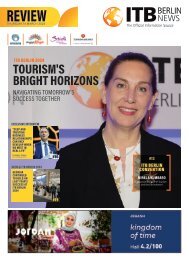ITB Asia News 2019 Day 1 Edition
Create successful ePaper yourself
Turn your PDF publications into a flip-book with our unique Google optimized e-Paper software.
ASIA - PACIFIC<br />
REGION<br />
23<br />
APAC attracts more travellers<br />
from around the world<br />
According to the UNWTO, <strong>Asia</strong>-Pacific recorded a 6% rise<br />
in international tourism in 2018, a trend which continues in<br />
<strong>2019</strong><br />
In the first half of <strong>2019</strong>, <strong>Asia</strong>–Pacific<br />
continued to see strong tourism<br />
growth, with a year-on-year rise of<br />
6% over the previous half, according<br />
to the September barometer of the<br />
UNWTO. South <strong>Asia</strong> and Northeast<br />
<strong>Asia</strong> reported 7% growth.<br />
Confidence in global tourism performance<br />
remains positive yet cautious and with signs of<br />
moderate growth for the remainder of the year<br />
according to the latest UNWTO Confidence<br />
Index.<br />
The World Tourism Organisation reported<br />
6% growth for <strong>Asia</strong> and the Pacific in 2018,<br />
reaching 343 million international tourist<br />
arrivals, equivalent to 25% of the worldwide<br />
total.<br />
Results in 2018 were driven by South-East <strong>Asia</strong><br />
(+7%) where most destinations posted strong<br />
growth, particularly Vietnam, a rising star in<br />
the region. China but also India stimulated total<br />
arrivals to the region. Indonesia and Cambodia<br />
enjoyed double-digit increases in arrivals while<br />
Thailand and the Philippines also recorded<br />
strong growth thanks to Chinese travellers.<br />
International arrivals in North-East <strong>Asia</strong><br />
increased 6% last year, led by South Korea<br />
which was rebounding from a weaker 2017.<br />
Japan continues its stellar tourism performance<br />
of the last six years by recording a growth rate<br />
of almost 19%. The country is now the third<br />
most visited destination in <strong>Asia</strong>.<br />
Macao (China) and Hong Kong (China) also<br />
reported solid results. Meanwhile, mainland<br />
China, the region’s largest destination recorded<br />
a 2% growth in the first three quarters of 2018.<br />
The opening of the Hong-Kong- Zhuhai-Macau<br />
Bridge in October 2018 is expected to enhance<br />
connectivity and boost tourist flows between<br />
the three cities of the Greater Bay Area.<br />
South <strong>Asia</strong> (+5%) also enjoyed a strong year,<br />
with Nepal profiting from higher inbound from<br />
India, China and European source markets<br />
thanks to a number of promotional campaigns.<br />
Sri Lanka, India and the Maldives all reported<br />
sound results<br />
6.2% HIKE IN<br />
INCOMING TOURISTS<br />
TO SINGAPORE<br />
Singapore attracted approximately 18.5<br />
million visitors in 2018, according to the<br />
Singapore Tourism Board. This number was<br />
a rise of 6.2% over 2017, which was likely<br />
due to an increase in arrivals from <strong>Asia</strong>, USA,<br />
and the United Kingdom. Top three markets<br />
included visitors from China, Indonesia,<br />
and India, due to strong travel demand and<br />
increased flight connectivity. Indian travel<br />
also escalated due to new cruise offerings<br />
from top cruise lines. Overall, 14 out of<br />
Singapore’s top 15 markets were able to log<br />
growth in 2018 and are expected to continue<br />
doing so through <strong>2019</strong>. Speaking monetarily,<br />
increase of tourism receipts was largely due<br />
to growth in entertainment, gaming and<br />
sightseeing.<br />
AUSTRALIA SEES<br />
MODEST RISE,<br />
BUT LONG STAYS<br />
DOMINATE<br />
Tourism Australia reports modest growth<br />
for the first half of <strong>2019</strong>, with y/y change<br />
up to the end of July of 2.9%. 9.36 million<br />
travellers entered the country in the first<br />
seven months; a rise of 260,500. While on<br />
the surface, the figures appear to be low, the<br />
fact that the average stay in Australia is 32<br />
nights gives the nation a major advantage<br />
when it comes to earnings through tourism.<br />
63% are return visitors, and on average,<br />
visitors spend over AU$5,000, amounting to<br />
a total of over AU$44bn.<br />
TOURISM RECEIPTS<br />
Results among <strong>Asia</strong>’s top tourism earners<br />
were solid, according to UNWTO. China<br />
recorded a 30% increase up to September,<br />
rebounding strongly from a decline in 2017<br />
as a weaker Yuan has made the destination<br />
more affordable. Japan and Macao also led<br />
results with a 19% and a 16% increase in<br />
tourism earnings respectively. Thailand<br />
recorded an 8% increase, following several<br />
years of double-digit figures.<br />
<strong>ITB</strong> ASIA NEWS • Wednesday 16 October <strong>2019</strong>

















